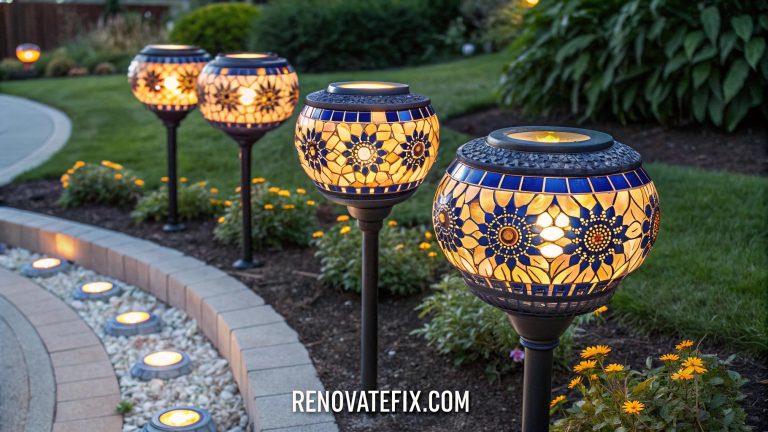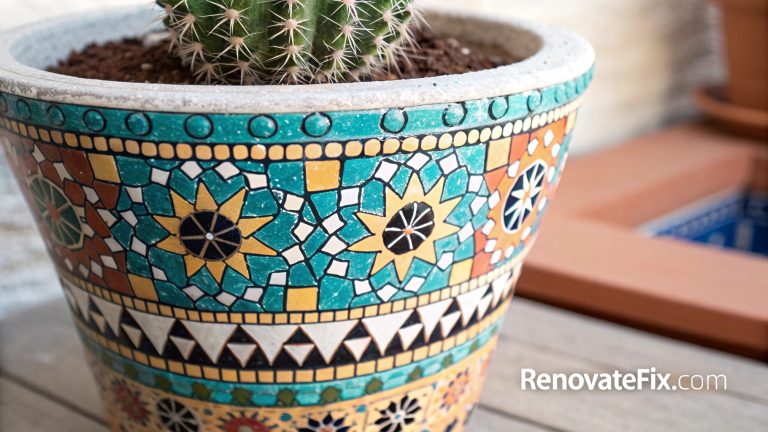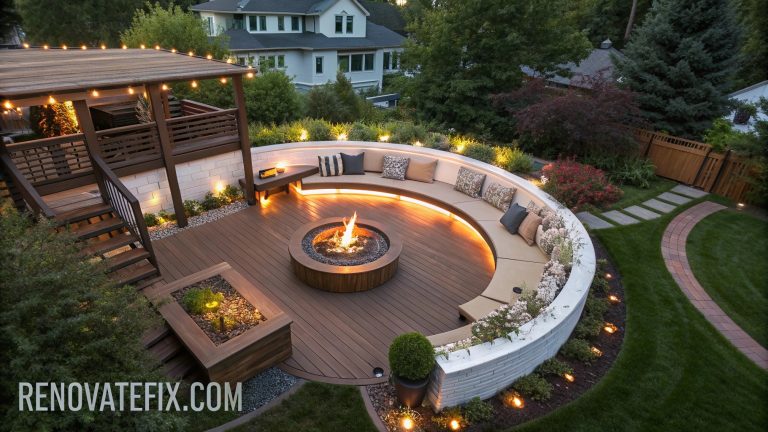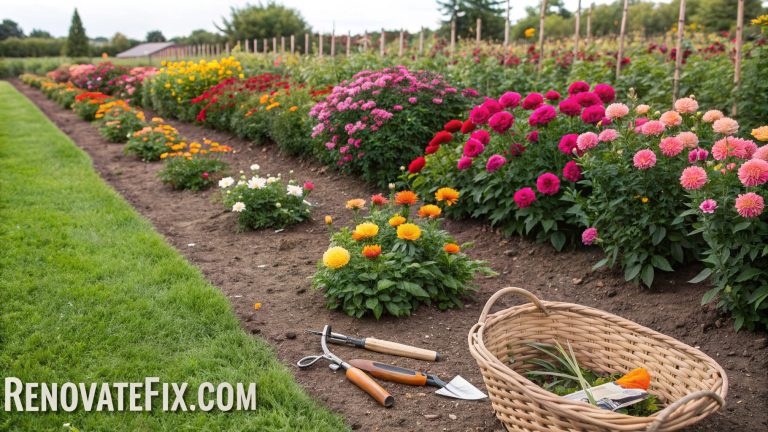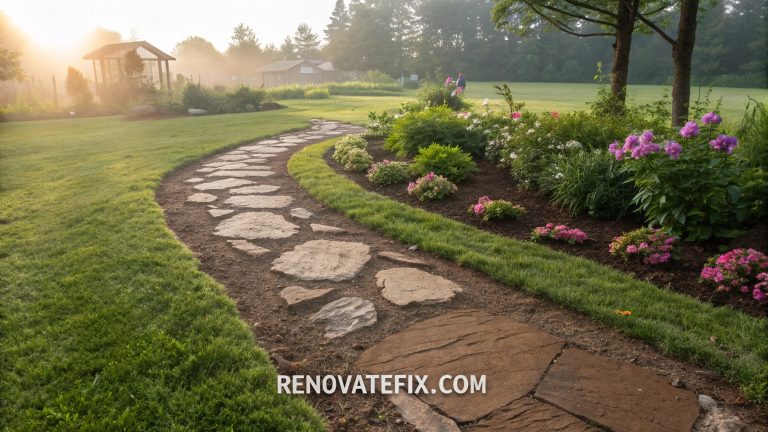20 Stunning Terracotta Pot Painting Ideas: Breathe New Life Into Clay
Terracotta pots offer a perfect canvas for artistic expression, allowing gardeners and craft enthusiasts alike to add personal touches to their plant displays.
The natural earthy tones of clay provide an excellent backdrop for vibrant colors, intricate patterns, and creative designs.
Whether you’re looking to brighten your garden space, enhance your interior decor, or create thoughtful handmade gifts, painted terracotta pots bring charm and character to any setting.
In this comprehensive guide, we’ll explore twenty imaginative ways to transform ordinary clay containers into extraordinary art pieces that showcase your creativity while complementing your botanical collection.
From minimalist motifs to elaborate artwork, these ideas will inspire you to pick up your paintbrush and turn simple garden vessels into conversation starters.
20 Terracotta Pot Painting Ideas
1. Geometric Pattern Play
Adorn your clay vessels with bold geometric patterns using masking tape as guides for perfectly straight lines.
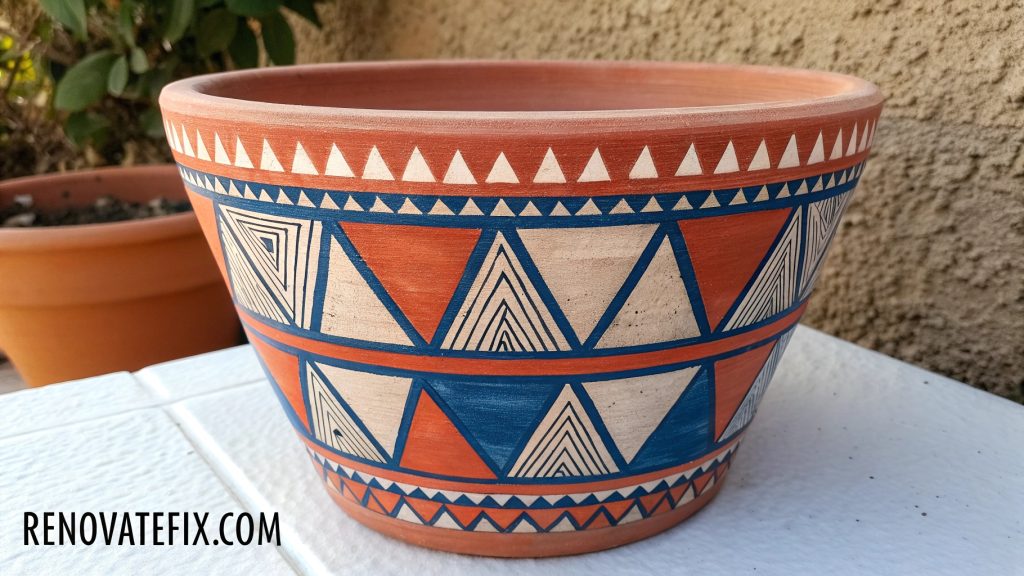
Combine contrasting colors like cobalt blue and coral against the natural clay background for a striking visual effect.
This approach works wonderfully on pots of various sizes and creates a cohesive collection when grouped together.
Your plants will stand proudly in these modern artistic containers that add architectural interest to any space.
2. Ombré Gradient Fade
Create a stunning visual flow by applying paint in graduated tones that seamlessly blend from dark to light.
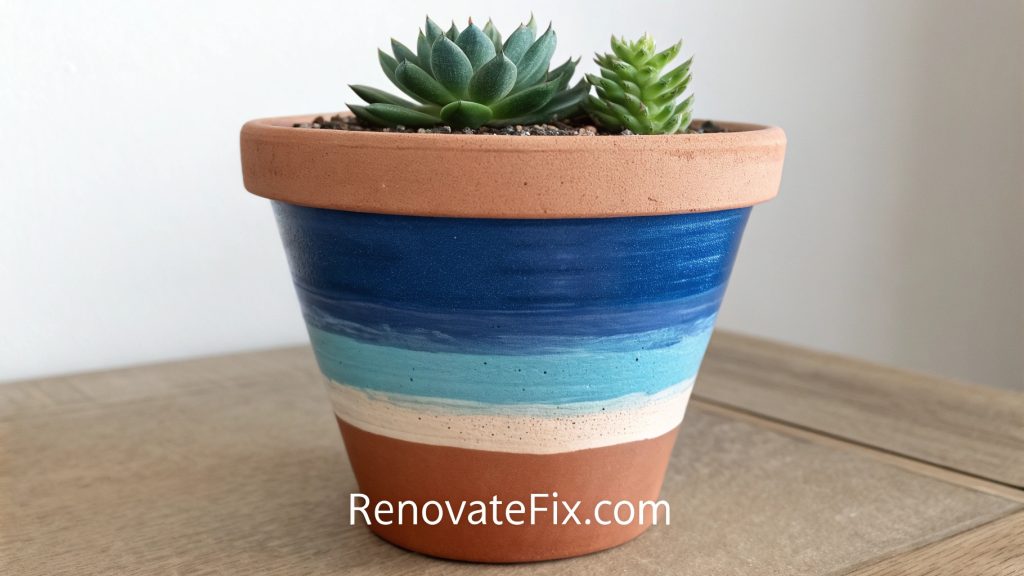
Begin with your darkest shade at the rim, gradually lightening as you work downward, allowing the natural terracotta to show at the base.
This technique gives depth and dimension to your planters while maintaining an elegant, artistic appeal.
The subtle color transition catches light beautifully throughout the day.
3. Folk Art Florals
Draw inspiration from traditional folk art by painting vibrant botanical motifs across your terracotta surface.
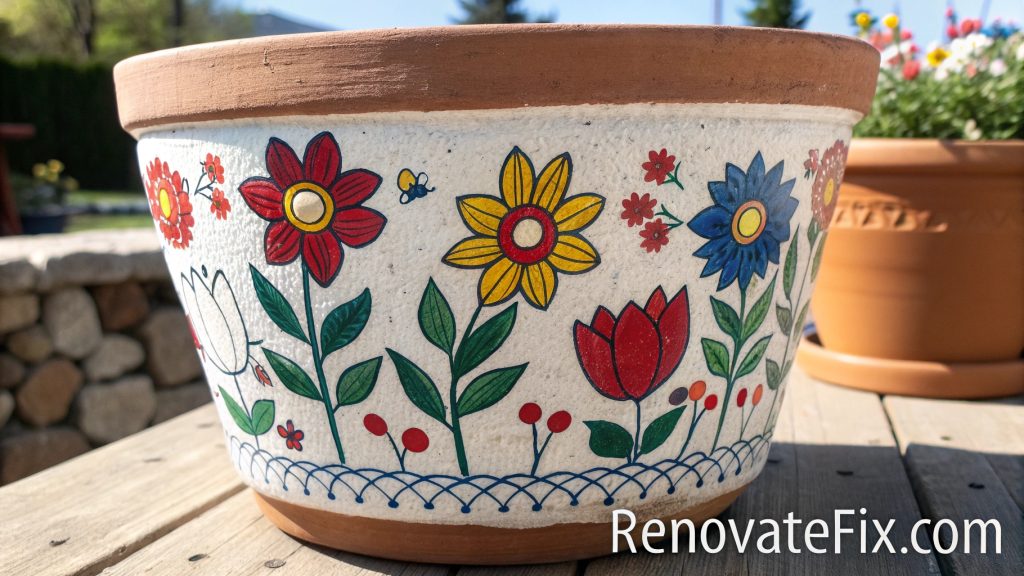
Use simplified flower shapes in bright hues against a solid background, adding small details like dots and dashes to enhance visual interest.
This rustic yet cheerful approach brings old-world charm to modern settings and pairs beautifully with cottage garden plants.
4. Marbled Swirl Effect
Achieve a luxurious marbled finish by mixing acrylic paints with water and pouring them over your pot’s surface.

Gently tilt the container to allow colors to flow and blend organically, creating unique swirling patterns that never repeat.
This approach yields magnificent results with minimal effort – each creation becomes a one-of-a-kind art piece displaying beautiful color interplay.
5. Celestial Night Sky
Paint your pot with a deep navy or black base, then add celestial elements like stars, moons, and planets using metallic paints.
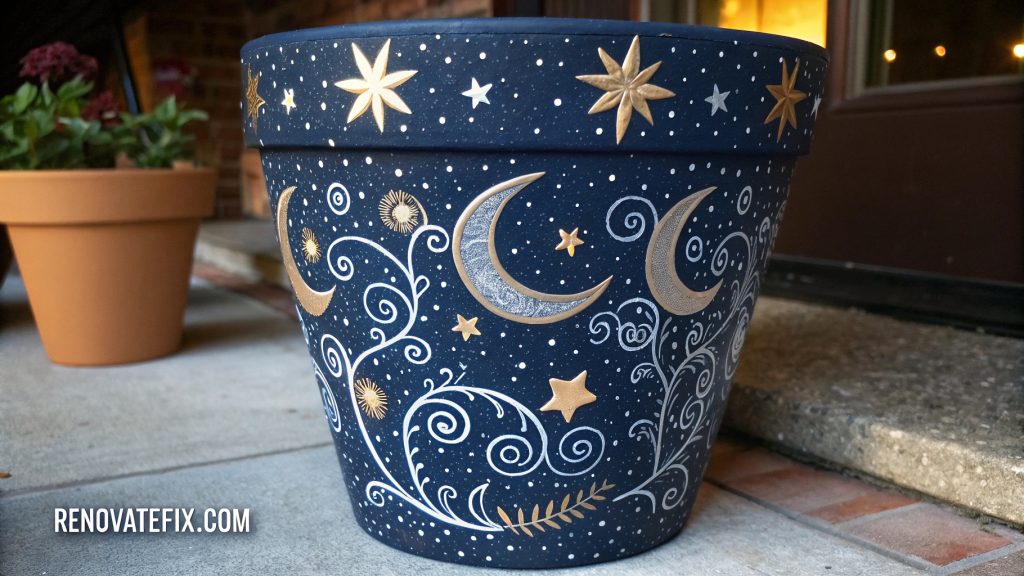
Create depth by varying star sizes and adding subtle nebula effects with soft brush strokes.
This cosmic approach works particularly well for indoor plants, adding mystical ambiance to your living space and looking especially captivating under subtle lighting.
6. Aztec-Inspired Patterns
Decorate your clay containers with bold angular patterns reminiscent of ancient Aztec art using earthy tones combined with vibrant accents.
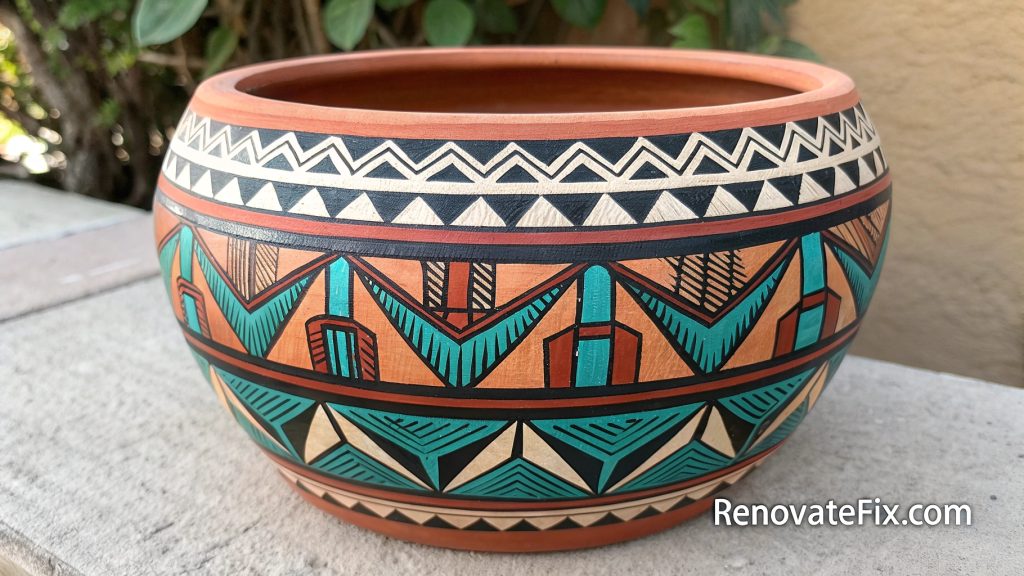
Focus on repeating triangles, zigzags, and step patterns that wrap continuously around the pot.
This striking approach brings historical elements into modern spaces while creating visually dynamic planters that showcase cultural inspiration.
7. Color Block Sections
Divide your pot into distinct sections using painter’s tape, then fill each area with solid colors that complement or contrast with one another.
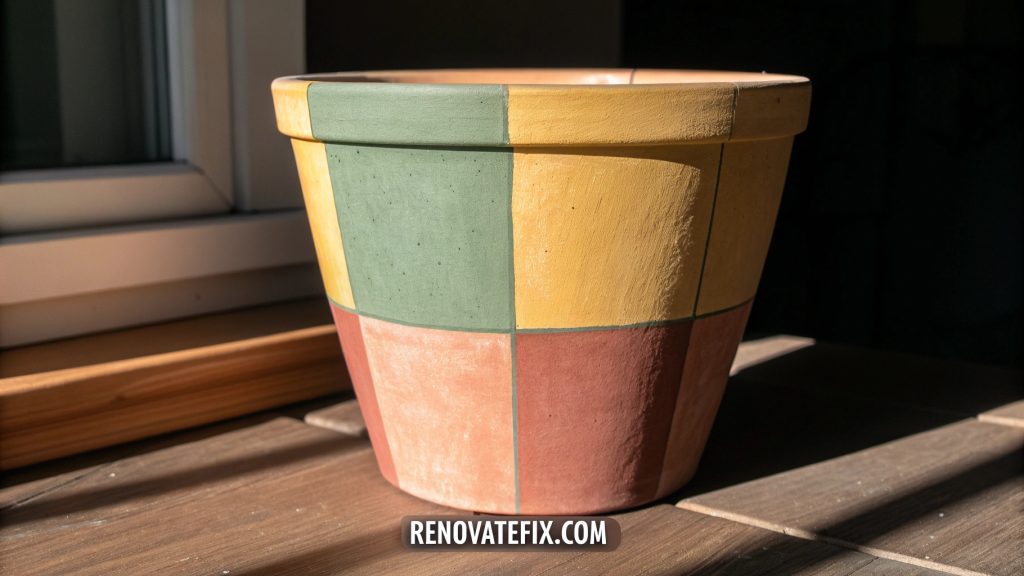
Once dry, remove the tape to reveal clean, sharp edges between color blocks.
This bold approach creates modern, graphic planters that make a strong visual statement while allowing you to incorporate specific color schemes that match your existing decor.
8. Distressed Vintage Finish
Apply a base coat of chalk paint, then strategically sand away portions after drying to reveal the natural terracotta underneath.
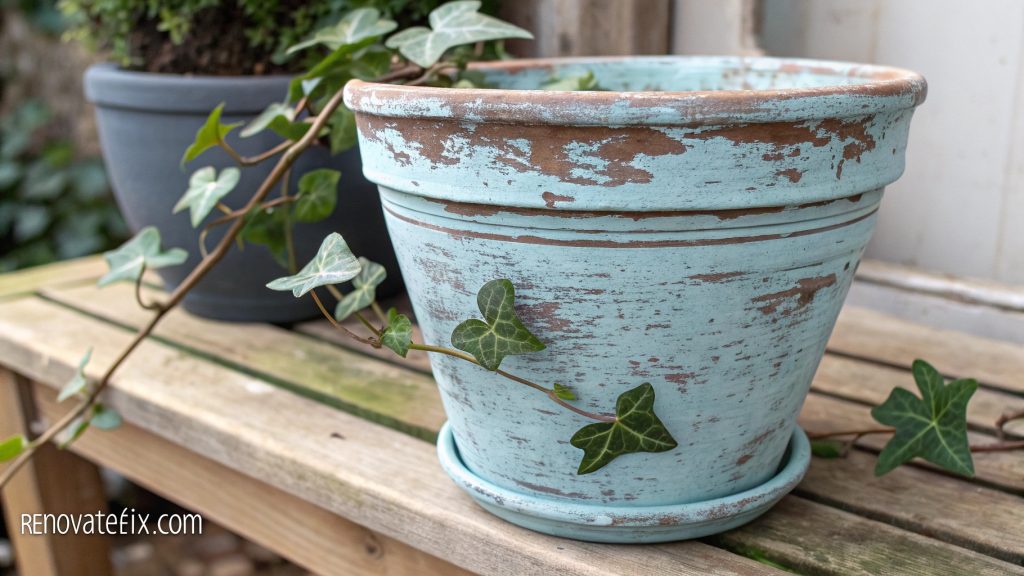
Add subtle aging effects by rubbing dark wax into crevices and edges.
This weathered aesthetic gives new pots an antique feel, suggesting they’ve been cherished across generations while adding rustic charm to both indoor and outdoor spaces.
9. Botanical Silhouettes
Paint your entire pot with a light-colored base, then add detailed plant silhouettes in contrasting darker tones.
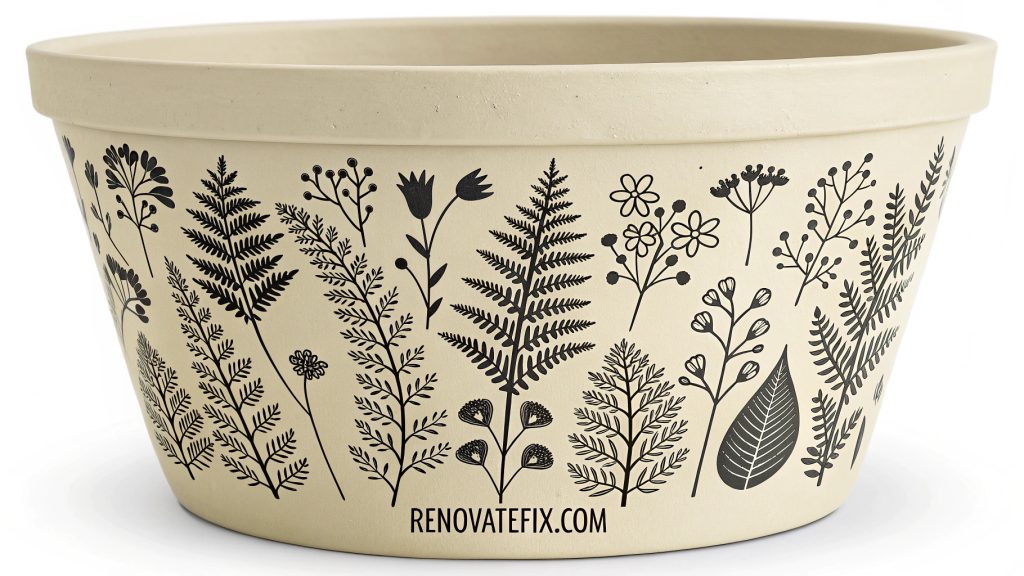
Focus on distinctive botanical shapes like fern fronds, palm leaves, or wildflower stems.
This elegant approach creates sophisticated planters that harmonize beautifully with their leafy occupants while bringing artistic botanical illustrations into three-dimensional form.
10. Abstract Expressionist Splatter
Channel your inner Jackson Pollock by applying random paint splatters across your terracotta surface.
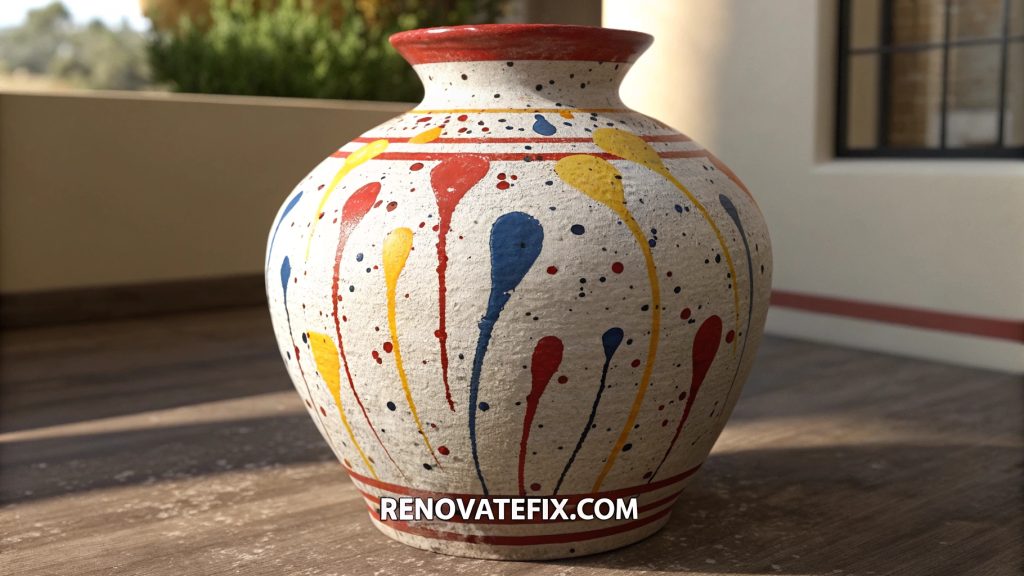
Use contrasting colors and various flicking techniques to create dynamic patterns that appear spontaneous yet balanced.
This artistic approach celebrates creativity and unpredictability, resulting in unique planters that serve as functional abstract art pieces for your home or garden.
11. Metallic Color Dipped
Create sleek, modern planters by applying metallic paint to just the upper portion of your pot, leaving the natural terracotta exposed below.
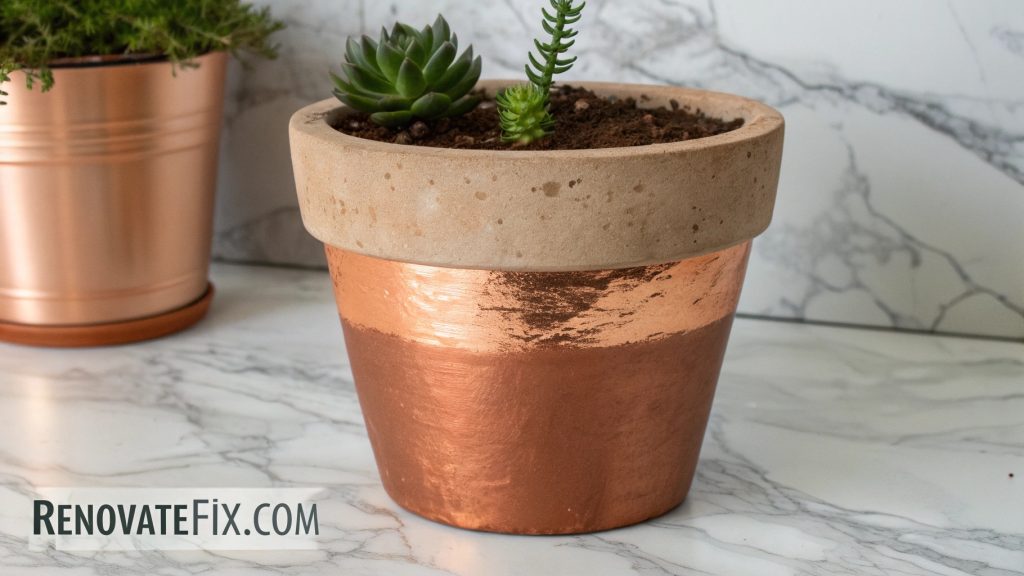
This half-dipped effect brings glamour to humble clay vessels while maintaining their organic appeal.
Gold, copper or silver finishes catch light beautifully, adding subtle sparkle to your plant display without overwhelming your space.
12. Hand-Painted Mediterranean Motifs
Adorn your pots with intricate patterns inspired by Mediterranean ceramics using blue and white as your primary palette.
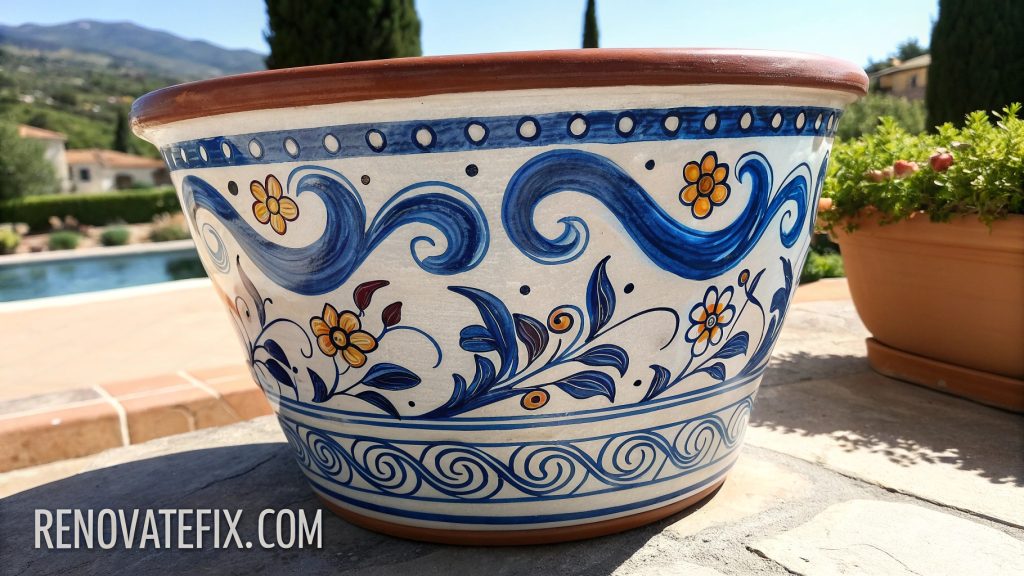
Paint curling waves, stylized flowers and geometric borders that wrap around the container.
This classical approach brings coastal elegance to your planters while referencing historical pottery traditions across Greek, Spanish and Portuguese cultural influences.
13. Animal Print Fusion
Paint bold animal print patterns across your terracotta vessels using unexpected color combinations that reinvent classic motifs.
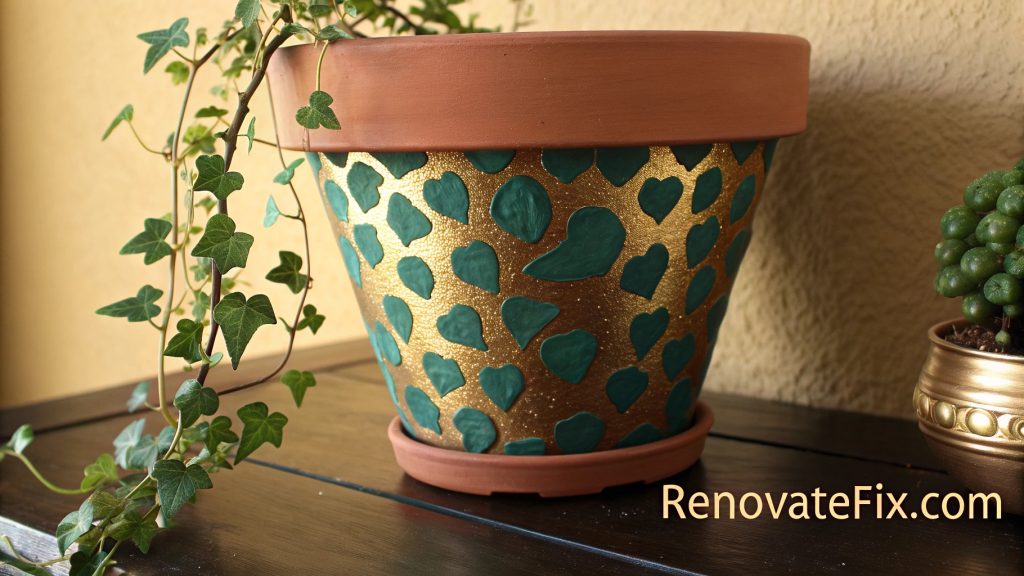
Try leopard spots in teal and gold or zebra stripes in purple and silver.
This playful approach brings wild energy to conventional planters while allowing creative expression through unconventional color choices that can complement your interior design scheme.
14. Rainbow Watercolor Wash
Apply diluted acrylic paints in rainbow hues that gently blend into one another, creating a soft watercolor effect across your terracotta surface.
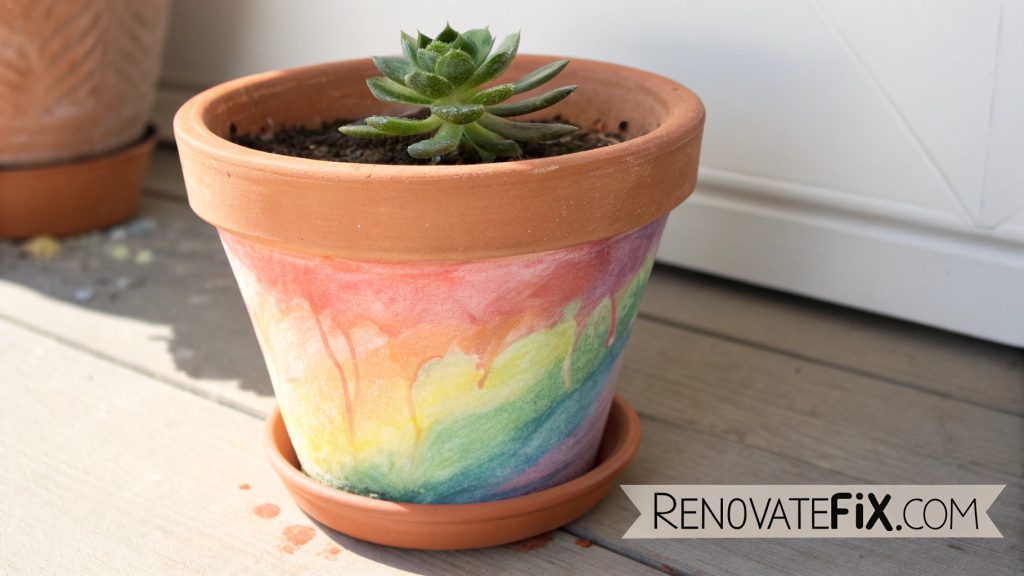
Allow colors to blend organically where they meet for a dreamy gradient. This gentle approach creates ethereal planters that bring subtle color to your space while maintaining an artistic, hand-crafted appearance.
15. Monochromatic Texture Play
Explore visual interest through textural variation rather than color diversity by applying various techniques in a single color family.

Combine stippling, cross-hatching, and smooth areas across your pot surface using different shades of one color.
This sophisticated approach creates subtle depth through texture while maintaining an elegant, cohesive appearance that works beautifully in minimalist spaces.
16. Word Art Typography
Encircle your pots with meaningful words, quotes, or plant care instructions using careful hand lettering or stencils.
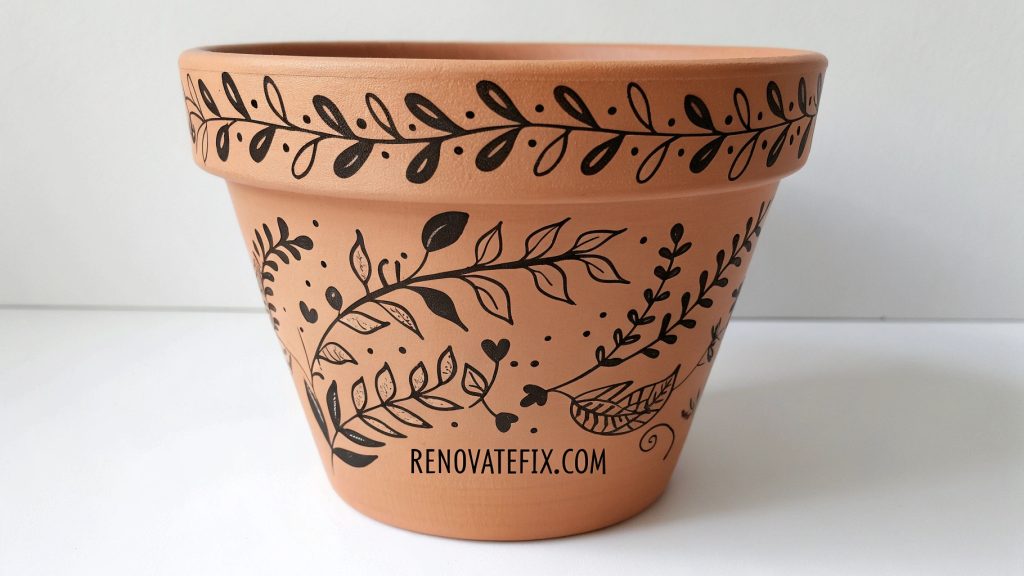
Choose fonts that reflect your personal style, from formal script to casual handwriting or bold block letters.
This functional approach adds personality to your planters while potentially serving as helpful reminders about watering schedules or plant varieties for your green collection.
17. Mosaic-Inspired Painted Patterns
Create vibrant designs that mimic actual mosaics by painting small geometric shapes in various colors positioned closely together on your pot surface.
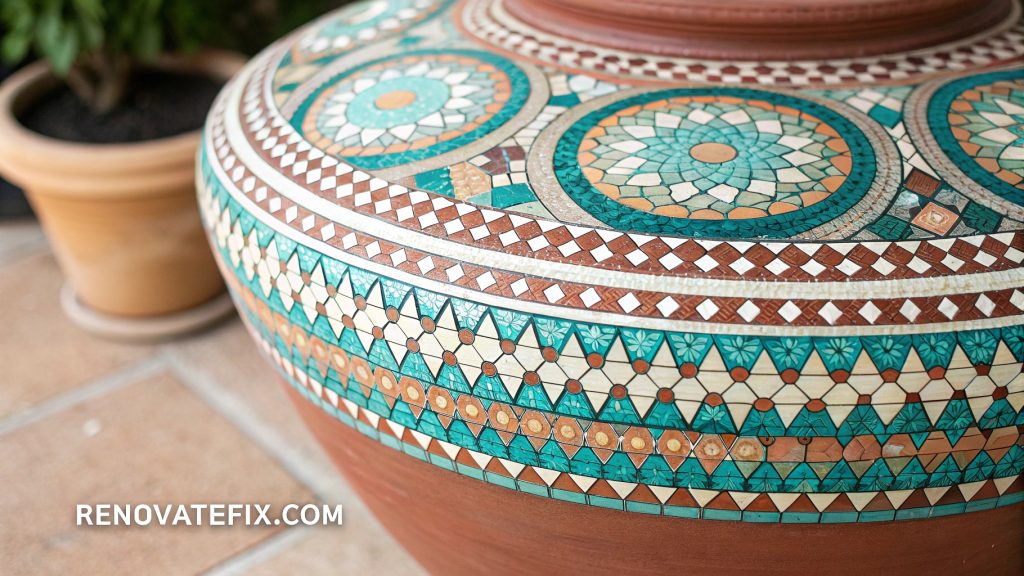
Use tiny squares, triangles, or hexagons arranged in patterns reminiscent of traditional mosaic artworks.
This detailed approach brings ancient decorative techniques into modern spaces through paint rather than actual tile work.
18. Nature-Printed Texture
Press leaves, flowers, or textured objects into fresh paint on your pot surface, then carefully remove them to leave behind detailed imprints of their natural patterns.
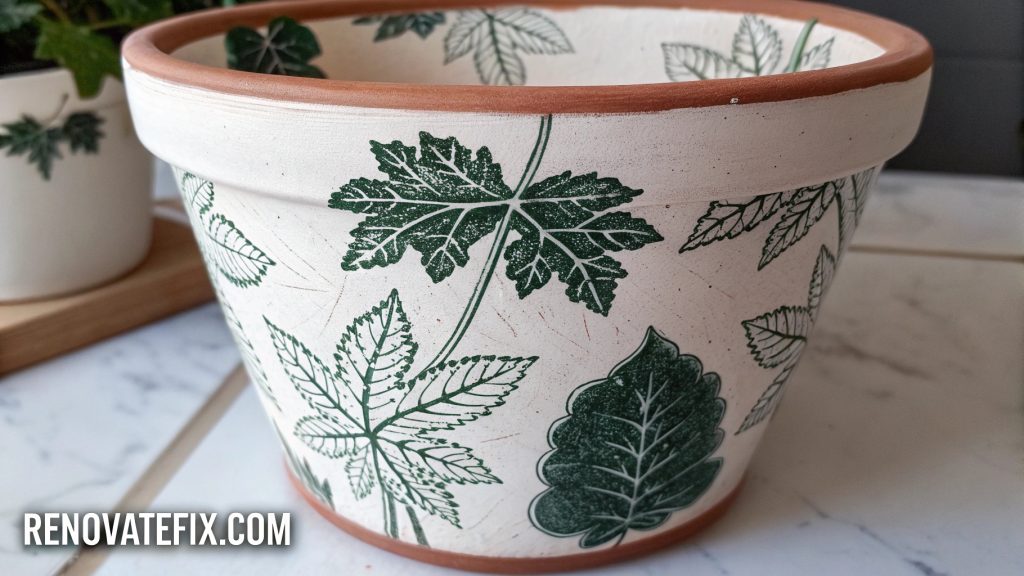
Try fern fronds, lace, or even bubble wrap for interesting organic textures.
This innovative technique creates subtle, sophisticated planters that celebrate natural forms through their impressed silhouettes.
19. Dripping Paint Effect
Apply thick paint at the rim of your pot and allow it to naturally drip downward, creating vertical lines of varying lengths.

Experiment with multiple colors or concentrate on a monochromatic palette for different visual impacts.
This dynamic approach balances controlled artistry with natural paint behavior, resulting in energetic planters with movement and visual rhythm.
20. Reverse Stenciling Technique
Place adhesive stencils on your terracotta pot, paint over the entire surface, then remove the stencils to reveal clean unpainted clay in precise patterns.
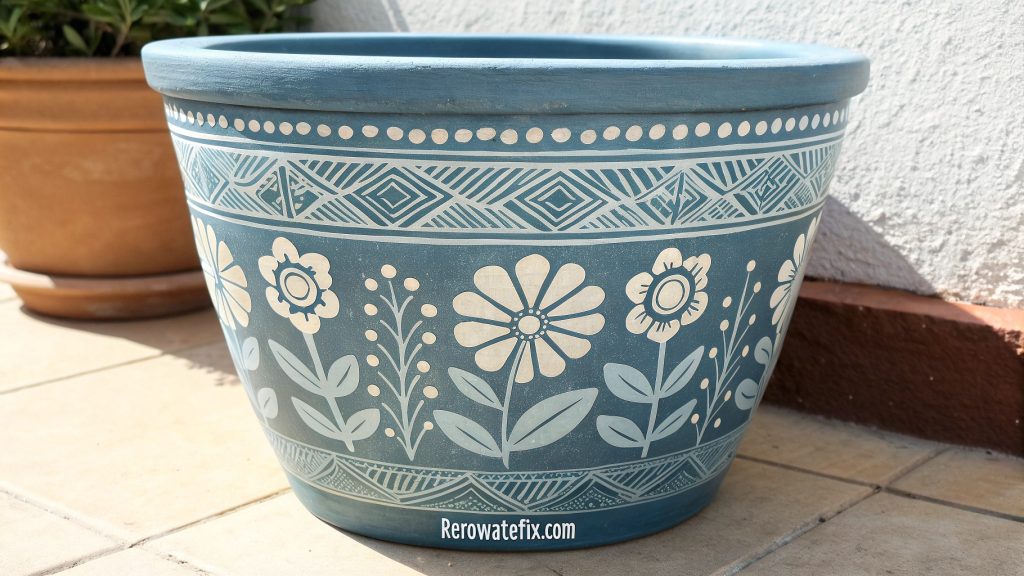
This negative space approach creates striking contrast between painted areas and natural terracotta.
Try overlapping multiple stencils for complex layered effects that bring dimensional visual interest to your planters.
Conclusion
Transforming ordinary terracotta pots into personalized art pieces allows you to express creativity while enhancing your living spaces with unique plant displays.
Each of these twenty painting ideas offers distinct possibilities for customization – adjust colors, scale patterns, or combine techniques to craft containers that perfectly complement your plants and decor style.
Remember that terracotta’s porous nature means sealing your finished work with clear protective coating will preserve your designs against moisture and fading.
The beauty of this craft lies in its accessibility; painters of all skill levels can achieve impressive results with basic supplies and a bit of patience.
Whether creating a cohesive collection using variations on a single technique or exploring different styles for an eclectic display, your painted terracotta pots will bring artistic flair to your botanical collection while providing endless opportunities for creative expression. Happy painting!


